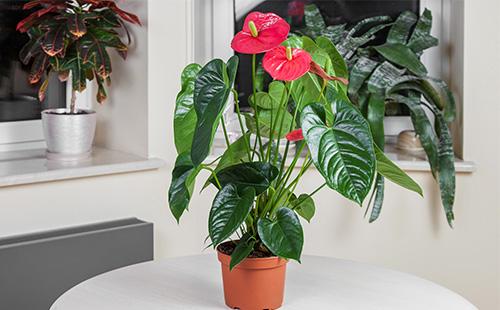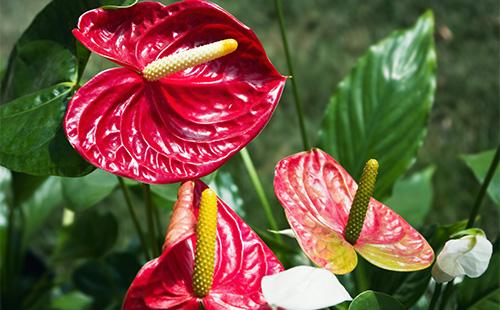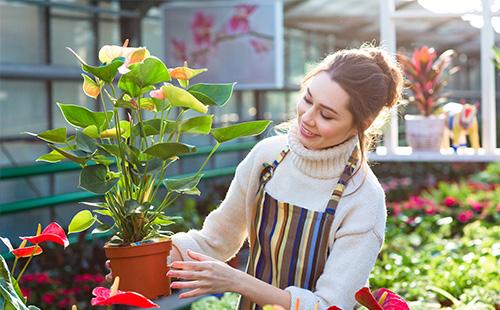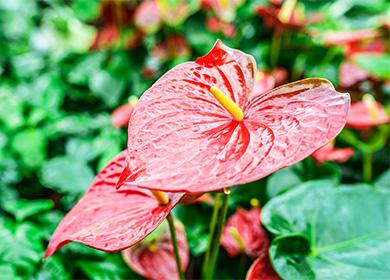The content of the article
- 1 Botanical Description
- 2 Varieties for the windowsill
- 3 After purchase - change
- 4 How to care for anthurium: creating the perfect climate
- 5 Breeding methods
- 6 Headache for flower growers: “leaving” problems and how to solve them
- 7 Pests
- 8 No flowering: reasons and what to do
- 9 “Capricious, but if you wish, friendship will work out,” - reviews and advice from flower growers
Anthurium has many names. Previously, flower growers called it "tailwood" for the characteristic shape of leaves and flowers. “Flamingo flower” is also anthurium. He received such a romantic name for graceful inflorescences that resemble graceful birds.
The tropical guest is popularly known as "male happiness." It is customary to give it to the representatives of the stronger sex. It is believed that the plant will make a man bold, successful, help in the "affairs of the heart" and ... increase the "masculine power." The atrium is also called the “flower of passion", so in the house where there is such a plant, the "spark" between the husband and wife will never go out. According to Feng Shui, a tropical guest on the windowsill promises material wealth and success in work. In a word, the flower is not only beautiful, but also energetically strong.
Botanical Description
In the natural environment, Anthurium is found in regions with a tropical climate. The perennial from the Aroid family is surprisingly diverse: biologists have more than 500 species. There are trees growing on the trees, rocks that have been chosen, and herbaceous plants.
All species have the same flower structure: an ear and a large bract-veil. But the color of the bedspread and the base of the inflorescence is different. White, yellow, all shades of red - this is just a small list. Petiole leaves of the flower, but in shape, color, size are all sorts: huge and small, plain and with pronounced veins, solid or carved. The duration of flowering depends on the variety and proper care: some species can delight you with flowers for a whole year without interruptions.
Varieties for the windowsill
Although a large number of varieties of anthurium are found in nature, mainly four hybrid varieties are grown on window sills. In greenhouses - more. Just not all tropical guests can adapt to the conditions of urban apartments. But even those that can are very moody.
- "Andre." A plant with a short trunk, leathery leaves, heart-shaped.This species conquered flower growers with fancy shades of inflorescences, expressive bracts and a year-round flowering period. Another feature of the variety: the cover after flowering does not fade, but coarsens, acquires a green color. But there are also disadvantages: reviews say that Andre is capricious, so it is difficult for beginners to provide him with proper care and blooming all year round.
- Scherzer. The least moody kind of “male happiness”. The plant is easier than other varieties to adapt to living conditions. You can recognize it by a shortened stalk, on which dark green elongated leaves flaunt. A distinctive feature is the roundness of the bedspread. The oval bract can be of almost any color: white, pinkish, burning red, yellow, and even speckled.
- "Crystal". This variety is grown to admire the leaves, because it blooms inconspicuously. But the leaves are really beautiful: large, heart-shaped, velvety, with bright silver streaks. The color of the foliage is changing: you brought home a flower with a bronze-purple veil, and, a year later, you received it with dark green.
- "Majestic". Like Crystal, it refers to decorative and deciduous. The flower grows quickly, its leaves can reach impressive sizes - about 40 cm. The leaf canvas is green (sometimes purple), distinct white veins appear on it. Growing this variety is difficult. A headache for gardeners is a tick-borne invasion. This type of “male happiness” is liked by insects more than other varieties.
After purchase - change
Have you looked closely at the “flamingo flower" and finally decided to bring this handsome man to your house? Naturally, you want to know how to care for anthurium ("male happiness") after the purchase. In order for the flower to take root in your house and please the eye with long flowering, it needs to be transplanted three days after purchase. It takes so much time to adapt.
Inexperienced flower growers always make a big mistake: they are afraid to transplant the plant immediately after acquisition, because usually it gets into the house already strewn with flowers. Indeed, it is better not to touch most flowering houseplants in the midst of the process, but not the “flamingo flower”. If you don’t immediately transplant the anthurium, then the foliage will fade and even blacken, the flowers will quickly fade, and new ones will not appear. Therefore, do not be afraid of the procedure: after the plant will thank you with abundant flowering, and in the case of decorative-deciduous species - with rapid growth. The main thing is to correctly transplant the flower “male happiness”, then this will not be stressful for him. Pay close attention to the choice of pottery and earthenware mix. Understand which transplant method is best. Follow these three tips.
- Pot. The rule applies: the vessel must correspond to the root system plus 3 cm of diameter "in reserve". Anthuriums grow best in small narrow vessels: this stimulates flowering. If the roots will have a lot of space, then the plant will please only the leaves. To achieve flowering is the main task of the owners of a houseplant, therefore only a cramped house. Plastic vases are optimally suited; you can take glass vases. But the clay should be abandoned: they cool off very much in the winter, the roots will be cold. In the best case, this will lead to a long period of rest, in the worst - to the loss of a flower.
- Priming. It is better to choose a special composition from the flower shop for the aroid. Suitable substrate for orchids. Be sure to use drainage: this way the roots will not rot. You can prepare the soil yourself. Combine moss, turf land and peat in a 1: 1: 2 ratio. By adding coarse sand or polystyrene, you can achieve breathability of the soil, which is a guarantee of long flowering.
- Transplant method. It’s better to transplant “male happiness” by transshipment. However, be sure to inspect the roots. If there is damage, rotten areas, then the roots are freed from a clod of earth, put in order, and only then planted. A young instance is transplanted annually. It is enough for an adult plant to “move” to a new house once every three years. It is advisable to plan a transplant from February to March (period of active growth).

How to care for anthurium: creating the perfect climate
Caring for a flower Anthurium is accompanied by certain difficulties. Of course, you can visit the forum and find out what kind of care is required for such a flower, but we will try to expand on the topic below. Growing problems are due to the fact that Anthurium is a tropical plant: creating suitable conditions for a capricious “pet” at home is not so simple. But nothing is impossible if you know the five subtleties of leaving.
- Lighting. A plant loves light; in the shade it grows poorly. But not everything is so simple: in direct sunlight, a flower can wither. Create a diffused light, and “male happiness” will delight blooming all year round. From the end of autumn, the anthurium needs to be highlighted and it will thank with luxurious colors.
- Humidity. In the rainforests where the “flamingo flower" comes from, it is humid. To make the plant feel at home, you need to create a special microclimate. Ideal humidity for the plant is 80%. An air humidifier will help in creating the right microclimate. Do not forget to regularly wipe the leaves (but not the inflorescences!) With a damp cloth, spray the plant, and place a container of water next to it.
- Temperature. The plant can adapt to temperature conditions. However, this is a thermophilic flower. The ideal temperature in the warm season is 20-28 ° C. In the autumn-winter period, the flower will be comfortable at 17 ° C. True, at this temperature, flowering is not always possible. Enemies of the plant - hot radiators, drafts, sharp temperature drops.
- Watering. In this regard, the plant is demanding. Watering should be plentiful, but beware of overflow. It is necessary to look for a “golden mean,” because it is equally harmful to dry an earthen lump and too saturate it with water. Check the drip tray after watering: drain leaking water. In summer, watering is more frequent: go to the flowerpot with a watering can once or twice a week. In the cold season, it is enough to water the plant once every seven days. Always be guided by the soil: the top layer has dried up - it's time to water the anthurium. The ideal option is melt water. But you can water and just defended, most importantly, not icy and not hard.
- Top dressing. In the spring-summer period, the “flamingo flower" needs to be fed. It is worth doing this regularly, every two weeks. It is most convenient to use purchased mineral fertilizers for aroid, orchids. Remember the useful advice from the owners of "male happiness": the dose that is indicated in the instructions should be halved.
Breeding methods
At home, the easiest way to propagate anthurium is vegetative, although seed reproduction is possible. Rooting is better in the warm season (ideally May-July), then a new plant will take root more quickly. You can divide the bush during transplantation, separate the "kids" or apical cuttings. Beginning gardeners are often confused by the information that they can propagate anthurium leaf.Such a formulation does not mean the rooting of one leaf, but the use of a stem with a leaf.

Vegetative
- When transplanting the plant, separate the shoots ("babies"), cut off the upper stem part or divide the lower stem, not forgetting about the roots.
- Drop pieces into a container. Provide a greenhouse effect (cover with plastic wrap or a glass jar).
- Watch for new plants: rooting should occur in two weeks. When two leaves appear on the sprout, it is planted in a separate container. Look after the new plant as well as the old.
Seeds
- “Dust” the flowers: to do this, use a brush to transfer pollen from flower to flower.
- When the berries ripen, take out the seeds. Rinse them with running water. They also practice two-hour soaking in a weak solution of potassium permanganate: this is protection against mold.
- In a shallow container, place pre-moistened foam rubber. Place seed material on it. Cover with foil.
- Sprouted seeds are transplanted into the ground. It is necessary to dive them at least three times, increasing the distance between new plants.
- When the seedling rises to 7 cm, it is ready for "independent swimming." Transplant it into a separate small bowl. Use a special soil mixture for aroid.
Headache for flower growers: “leaving” problems and how to solve them
Cultivating “male happiness” at home is not easy because of its capricious nature. Instead of admiring the beauty of the plant, one often has to think about how to save the "pet." Why does the anthurium turn black leaves, the plant begins to turn yellow and dry out? Most diseases of the “flamingo flower" are due to improper care. You can save the plant if you work on the bugs. And here it is important to determine the cause of the problem, which will help the following table.
Table - Problems in growing anthurium and their causes
| Problem | The reasons |
|---|---|
| Leaves turn yellow | - Long-term waterlogging of an earthen coma; - chlorinated water; - too concentrated recharge; - insufficient lighting; - close capacity |
| Blacken leaves | - Drafts; - too dry air; - violation of the temperature regime (too hot or cold); - direct rays of the sun; - substrate with an excess of potassium |
| Brown spots | - Waterlogging; - unsuitable soil; - damage to the root system; - root hypothermia; - hard or too cold water |
| The tips of the leaves are dry | - Anthracnose (weakened plants, flowers with mechanical damage) |
| The plant dries up | - Inadequate watering; - dry air |
| Leaves curl | - Drafts; - dry air; - lack of light |
| Withering foliage | - Rotting roots from overflow |
To “flamingo flower” for a long time pleased with its beauty, you need to study all the subtleties of care. If comfortable conditions are created for the tropical guest, the leaves will have to be cut only from “old age”, and not because they have lost their attractiveness.
Pests
Pests may be to blame for the loss of beauty of anthurium.You need to fight them without delay if you do not want to lose a green friend. Five of the most common parasites can be distinguished.
- Aphid. Insect colonies are located on the inside of the leaf, but it is difficult to notice them. Usually, flower growers learn about the problem by the consequences: “male happiness” dries, its growth slows down, twisted leaves appear. It is necessary to fight aphids with insecticides - chemical or biological.
- Scaffolds. Convex tubercles on the leaves indicate the attack of scale insects. They are oval, in color - beige or brown, easily separated with a toothpick. Insects suck the juice from the plant, which leads to a slowdown in the growth and death of anthurium. To solve the problem, buy a systemic drug at the flower shop. Contact insecticides are powerless here. After the main treatment, the plant is sprayed with mineral oil.
- Spider mites. It is almost impossible to see the “dirty tricks”, one can only guess that they chose a flower by its thin cobweb and dotted, light yellow punctures on the leaves. Over time, the plant begins to languish and dies. Acaricides will help to solve the problem. First you need to wipe the leaves with a sponge dipped in soapy water (laundry soap and water).
- Thrips. Flies infect plants with viruses, leave excrement on the leaves that attract the fungus. The “activity” of thrips leads to a change in the color of the leaf surface to yellow-white. To combat flies use specialized drugs, sticky traps.
- Whiteflies. It’s easy to find butterflies: they fly apart from the movement. But you can determine their presence by the appearance of the leaves of anthurium: they curl, lose color, “sugar stains” appear on the canvas (white sticky coating). Insecticides are effective in controlling whiteflies.

No flowering: reasons and what to do
Anthurium most often gets into a flowering house. In this form, the plant is usually sold. The "flower tail" fades, and the owners begin to look forward to the next "shooter" with luxurious bedspreads. But time passes, and the flowers never appear ... Why doesn’t “male happiness” bloom?
Usually, the reasons are due to improper care:
- lack or excess of light;
- violation of the irrigation scheme;
- intense heat or, conversely, coolness;
- drafts;
- unsuitable soil;
- incorrectly selected pot;
- damage to the root system during transplantation;
- lack or excess of nutrients.
A plant that is sick or affected by insects does not bloom: it simply does not have enough strength for this. Weaken the anthurium and faded buds, which the grower was too lazy to remove. If you want to enjoy the beauty of blooming “male happiness” for a long time, cut off the inflorescences as soon as they begin to fade. Leave “arrows” with a faded leaf only if seed propagation of the plant is planned.
Growing anthurium at home is not an easy task. But the “flamingo flower" is a grateful plant. If you create the necessary conditions, optimize care, protect from insects, Anthurium will surprise you with its beauty almost all year round. Use the life hack from experienced gardeners to make “male happiness” blossom: in the very beginning of spring, pour hot water on the plant (40-50 ° C). "Temperature shock" invigorates the "passion flower." Provided that you cope with the care and the plant is healthy, after hot watering, the rapid formation of inflorescences will begin. All that remains is to admire your “pet” and receive compliments to your floricultural skills!
“Capricious, but if you wish, friendship will work out,” - reviews and advice from flower growers
When the flower bloomed, I transplanted the anthurium into a new pot with plain earth. Important - this flower is poisonous! Keep away from children and wash your hands thoroughly after contact with it.The roots are very fragile and brittle, be careful when transplanting! By the way, they recommend replanting it every spring. The pot should not be deep, but ideally wide. I didn’t have this when transplanting. At the bottom of the pot when transplanting, I put expanded clay so that it absorbs excess moisture. Anthurium. like any tropical flower, warm and moisture-loving. In winter and summer, the temperature should be high enough, no drafts for him. Humidity is high if possible. Unlike the money tree, anthurium must be regularly watered so that the soil is always in a moist state. Leaves should be sprayed as often as possible (then they will be without holes).
ila3, http://otzovik.com/review_367498.html
Young stems of anthuriums can be wrapped with fresh sphagnum moss. And add more to the soil when transplanting the same sphagnum. Anthuriums have been living with me. I don’t remember how many years already. Perhaps because I live in a wooden house, our air is more humid ..
Glacha http://indasad.ru/forum/27-uchod-za-komnatnimi-rasteniyami/459-anturium-ukhod-i-razmnozhenie
I love this flower. At my place are two Anthuriums Andre, pink and orange, and Scherzen two, red and purple. At first, two bought chic flowers ruined. The main reason for this is not properly selected land! These dead flowers, and they died from the fact that the roots rotted, I planted in universal soil + drainage to the bottom. Now I plant my anthuriums differently. I add sand to the universal earth, and a lot of sphagnum. Drainage required. The earth turns out to be very airy, the roots breathe, and dry well. I water abundantly every 7-10 days. This is Andre. And I water the Shertsens more often, they immediately folded leaves from a lack of moisture. Spray and wipe. Often I water with Zircon and spray with Epin. That's how I made friends with them, now they don’t live.
Tim82, http://irecommend.ru/content/moi-opyt-vyrashchivaniya-anturiumov

